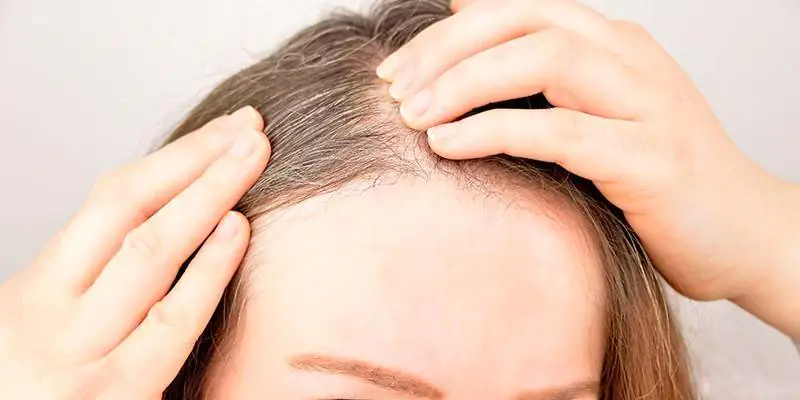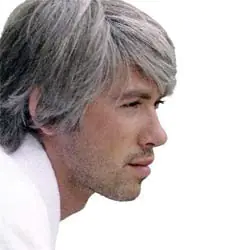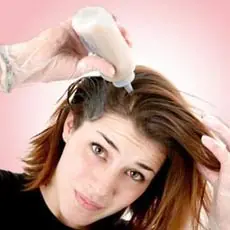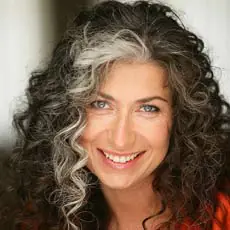For a long time it was believed that the appearance of gray hair indicates the decline of the body, a turn from youth to old age. Gray hair? Pull him out quickly! It's time to dispel this myth: gray hair has nothing to do with age!
Cosmo recommends
The hit of the summer - loose white jeans that every fashionista should have
Romance! Fashionable polka dot dresses for a gentle summer look
Trichologist Joe Cincotta participated in a large study in which thousands of volunteers agreed. A group of scientists monitored the subjects’ diet, their lifestyle, the amount of stress and nervous tension, and correlated this with hereditary factors, skin and hair color, gender and age.
The conclusions that scientists have reached are impressive.
Firstly, stress does not play a significant role in the formation of gray hair. Among the study participants were people experiencing very serious life dramas, from the loss of a business to the death of loved ones. None of them showed the appearance or increase in the number of gray hairs immediately after a stressful situation. So the expression “Gone gray overnight” is nothing more than a beautiful metaphor.
Secondly, a decrease in the production of melanin, which is responsible for the presence of pigment in the hair, does occur with age, but for each person - at an individual rate, which does not depend on the region of residence, nor on diet, nor on the amount of physical activity, nor on general condition of the body. Absolutely healthy people sometimes turn gray at the age of 20, and those suffering from severe chronic diseases do not have a single gray hair by the age of 50.
Mane, come back! 8 reasons for hair loss - and how to improve the situation
The third conclusion: taking vitamins and dietary supplements is not able to slow down the appearance of gray hair. There is not a single proven effective set of dietary supplements that would stimulate melanin production.
The fourth conclusion: gray hair is in no way interconnected with other processes in the body that are traditionally considered age-related. Neither the appearance of wrinkles on the skin, nor changes in joint and bone tissue, nor the condition of internal organs, nor metabolism - all this has nothing to do with the presence or absence of gray hair.
And finally, plucking gray hairs, early resort to coloring, and any hair and scalp care procedures also have no effect on the process of gradual loss of pigment.
The culprit behind the occurrence of gray hair has nevertheless been found: it is a genetic factor. The sooner your parents started going grey, the sooner you will most likely go grey. And on the contrary, if in a family traditionally gray hair appeared in people at a very respectful age, you also don’t have to worry about the early appearance of silver strands.
So, get out of your head the worries about “Oh my God, I’m getting old, I have a gray hair on my temple!”, and if this gray hair bothers you, read our material about the most fashionable hair colors of the season!
One of the signs of mature age is the appearance of gray hair. If hair begins to turn gray at a young age, then this is a clear sign of some abnormality in the woman’s body. Early graying is considered to be graying that appears at the age of 20-30 years.
Mechanism of hair bleaching
The appearance of gray hair is a natural physiological process. The mechanism of its formation does not depend on age. Gray hair develops equally in both mature women and young girls. Melanin, a pigment produced by melanocytes located in hair follicles, is responsible for hair color. They synthesize ossimelanin, pheomelanin, eumelanin and triochromes. All of them are varieties of melanin. The formation of gray hair occurs in several stages:
- After 30 years of age, every 10 years the functions of melanin fade away by 10-20%.
- There is also a gradual death of melanocytes. As a result, melanin synthesis slows down and then stops completely.
- First, when melanocytes age, the coloring pigment is displaced, starting from the roots. Subsequently, the entire hair becomes bleached.
- Due to the lack of melanin, the hair structure becomes porous.
Causes of early gray hair in women
There are three types of hair graying: physiological (age-related), congenital (associated with the lack of pigment in the hair), and presenile. The latter type represents early gray hair in women, which manifests itself before the age of 30. With physiological graying, melanocytes age. In the case of premature graying, the activity of pigment-producing cells decreases or their complete death occurs.

Domestic
The cause of gray hair at a young age may lie in various diseases of the internal organs. Separately, it is worth noting genetic predisposition. If representatives of the older generation had early gray hair, then most children will inherit this feature. Other more serious causes of gray hair at a young age:
- Deficiency of vitamins or microelements. Early gray hair can be caused by a lack of manganese, selenium, copper, and zinc. The same applies to deficiency of vitamins A, B, C, and iron deficiency anemia.
- Severe stress. Due to the production of adrenaline in a stressful situation, the connection between melanin and hair protein may be disrupted.
- Unbalanced diet. Addiction to mono-diets and strict diets causes a lack of vitamins and minerals, which impairs the function of melanocytes.
- Bad habits. Alcohol abuse and smoking cause premature aging of the body.
- Diseases of the endocrine system and digestive organs. They provoke metabolic disorders, which also affects the hair.
- Diseases that cause pigmentation disorders. These include albinism, vitiligo, and tuberous sclerosis. Gray hair can appear at any age.
- Premature aging syndrome, including progeria and Werner's syndrome. These are very rare diseases. With them, a person also has other signs of aging, such as weak bones, wrinkling, cataracts, etc.
- Hormonal imbalance. Women are characterized by unstable hormone levels during pregnancy, menopause, and polycystic ovary syndrome. This can provoke exhaustion of the nervous system and endocrine pathologies.
- Autoimmune pathologies. They cause the production of antibodies that destroy melanocytes.
- Cardiovascular diseases. They cause oxygen starvation of the hair follicles, which causes a lack of melanin.

External
The state of melanocytes is also influenced by some external factors. Most of them are not associated with any diseases. The more negative external factors are observed simultaneously, the higher the risk of early gray hair. Thus, gray hair in women at the age of 30 can be a consequence of:
- Negative effects of ultraviolet radiation. Prolonged exposure to the sun causes a decrease in the amount of melanin.
- X-ray exposure. May cause patchy early greying.
- Bad ecology. Promotes early aging of the whole organism.
- Taking medications. This is especially true for antibiotics, which negatively affect immunity and metabolism.
- Improper or insufficient care of the scalp and hair. This includes exposure to the cold or sun without a hat, the use of aggressive products, frequent dyeing, bleaching with hydrogen peroxide, perm and styling.


It is considered normal for our hair to change color as we age; At the same time, it is considered the norm (albeit purely conditionally) if noble gray hair whitens the heads of people who have crossed the threshold of middle age.
At the same time, there are many elderly people in the world whose hair, it seems, is not at all affected by the years they have lived. But there are even more of those who began to go gray long before middle age. And even teenagers or young adults in their early 20s may find themselves with a strand of gray hair.
The human body has millions of hair follicles (hair follicles) throughout its surface. This is, in fact, the root of the hair, in which special cells (melanocytes) produce different types of melanin, which determines the color of the hair. Over time, hair follicles lose pigment cells, which leads to gray hair. This is how they usually explain the process of the appearance of gray hair in a person who, in fact, is already high time to go gray due to objective age-related reasons.
But why do young people turn gray? And why can gray hair be found even in small children? Does this indicate some kind of health problem, or is genetics to blame? In this article, you have the opportunity to not only learn about some of the most common causes of early gray hair, but also learn how you can slow down the process or even prevent it (to some extent, of course).
Early gray hair: causes that can be eliminated

When it comes to the premature appearance of gray hair and measures to combat this phenomenon, you should know that without accurately identifying the causes of gray hair, it is impossible to stop this process. And if you know the list of the main reasons, then you can take measures to prevent the appearance of gray hair at an early age.
In fact, there are not so many reasons for these, besides natural aging; and the number of products that are offered to combat gray hair is off the charts.
This is not surprising, since gray hair is a huge business for companies filling the relevant market niche with numerous hair dyes (and more). It is no coincidence that many large companies contribute to the study of the problem of the appearance of gray hair at different ages (at least at the level of collecting statistical data). For example, cosmetics giant L'Oreal found that gray hair in men aged 45 to 65 years is slightly more common than gray hair in women of the same age (78% to 71%); and at 50 years old, gray hair accounts for an average of 25% of all hair on the head (for most people).
Why does hair turn gray early?

The process of early gray hair is affected by a lack of any of the following vitamins in the body: vitamin B-6, B-12, biotin (the so-called antiseborrheic vitamin or vitamin H), vitamin E. In addition, in 2005, in the peer-reviewed scientific publication Development The results of several studies were published at once, proving that the process of formation of gray hair is also affected by a deficiency of vitamin D-3, B-12 and copper deficiency in the human body.
In 2016, another international publication (International Journal of Trichology), dedicated to the problems of trichology (that is, the science of hair), also drew attention to the factors that are associated with the premature appearance of gray hair in young people (up to 25 years). The subjects were found to be deficient in the iron-containing protein ferritin (which is a source of iron for cells), the same vitamin B-12 and “good” cholesterol (HDL, high-density lipoprotein).
Taking as a basis the fact that a deficiency of the above nutrients affects the formation of the necessary pigment in our body, it was assumed that appropriate vitamin supplements would help restore hair color.

If we are not talking about genetic causes of premature graying, then the next “accused” may be so-called oxidative stress (that is, cellular damage due to oxidation processes). Oxidative stress results in an imbalance where antioxidants (that is, oxidation inhibitors) are unable to cope with the destructive effects of free radicals (molecules that trigger the process of cell death, leading to disease and aging of the body).
The term often used is more pronounced oxidative stress: we are talking about more serious cellular damage that can become a trigger for various diseases, including one of the very dangerous pigmentation disorders - vitiligo. Vitiligo can also cause gray hair as a result of a decrease in the functional activity of melanin-producing cells or as a result of their death.

There is a common belief that everyday stress leads to premature gray hair. In fact, no study has yet proven this connection.
For example, studies that have sought to find an association between stress caused by bodily injury have produced conflicting results.
One such study from New York University, published in the medical scientific journal Nature Medicine, found that when the human body is under stress, the functionality of the cells responsible for hair color decreases.
However, there are other studies, the results of which, although they confirm that stressful situations can influence this process, lead to additional conclusions. According to them, this influence is just a small touch in the overall big picture, consisting of other numerous causes (for example, concomitant diseases, genetic factors, and so on).

Chemical dyeing and hair extensions (and even some types of shampoos) can also cause gray hair to appear at an early age. And this is not surprising, since many cosmetics contain harmful substances that reduce melanin levels. For example, one such harmful chemical that is found in many chemical hair dyes is hydrogen peroxide. And if you use hair lightening products very often, you can eventually cause the corresponding damage, leading to the premature appearance of gray hair.
How to get rid of early gray hair?

A person’s diet plays a clear role in preventing the appearance of early gray hair. Foods containing antioxidants help reduce free radicals by stopping a process called oxidative stress. This is also the easiest way to prevent premature gray hair, as antioxidants are found in fresh vegetables and fruits, green tea, olive oil, fish and many other foods.
As for smoking, everything is clear: if you, as a smoker, are concerned about the problem of early appearance of gray hair, it makes sense to immediately quit smoking. It’s better not to start. Well, if the main reason for the early appearance of gray hair is a deficiency of vitamins, you need to include in your diet foods that contain the vitamins the body lacks. For example, seafood, eggs and meat are sources of vitamin B-12; milk, salmon and cheese are an excellent source of vitamin D.
Deficiencies of certain micronutrients in the body can also be corrected through regular consumption of certain foods. For example, if you have been diagnosed with a copper deficiency, you should include foods such as beef liver, lentils, almonds, dark chocolate, asparagus, and so on in your diet. If necessary, it is possible to adjust the intake of certain vitamins and minerals by introducing appropriate vitamin and nutritional supplements into the menu.

Now there are a lot of hair dyes on the market that can hide gray hair. There are also many anti-gray shampoos that promise quick and safe “camouflage” of hair.
Unfortunately, many of these cosmetics themselves cause even more gray hair to appear prematurely; in addition, their regular use leads to numerous side effects and allergic reactions.
Natural medicines are a very real alternative, as they help reduce the formation of gray hair without having a negative effect on the skin.
Let's take for example curry leaves. The use of curry leaves as a natural medicine goes back centuries. Nowadays, many people use curry leaf hair care oil (which, by the way, is easy to wash off) as it can slow down the premature appearance of gray hair. Curry leaves are also used to help dark hair retain its natural color longer.
If such a remedy seems too exotic to someone (although getting it now is not a problem), you can use infusions of nettle, sage, and other herbs. Even regular black tea is recommended, and in tea bags.
You should steam two or three tea bags in a regular cup, then wait until it cools down and apply to clean, damp hair. After regular use, hair becomes darker, softer and has a healthy shine. Some people mix the tea with hair conditioner, apply it for one hour, and then rinse their hair.
Early gray hair in a child

Early gray hair, of course, can be a cause for some concern, which, however, is most often caused by purely psychological factors due to a violation of aesthetics.
However, the unexpected discovery of gray hair in a child can cause a real panic attack in his parents. However, there is no need to panic, since the appearance of gray hair in a child is caused by exactly the same reasons that cause early gray hair in young men and women.
But you shouldn’t ignore this fact. You should find out which of the above reasons leading to the appearance of gray hair at such an early age apply to your child. Most likely, it will be problematic to do this yourself, and therefore it is worth contacting a specialist. Considering the fact that we are talking about a child, you should initially make an appointment with a pediatrician and explain to him the essence of the problem; and the pediatrician will decide whether there is a need to contact other specialists for further examination in order to identify the causes of the lack of color pigment.
Treatment of early gray hair in Russia
In the international medical space, a separate scientific direction dealing with hair arose in the middle of the last century; in Russia, doctors specializing in hair health (that is, trichologists) appeared only at the beginning of this century.
Moreover, such a specialty still does not officially exist in our country: there is a cosmetologist or a dermatologist. Much of the modern data (including statistical data) that we have on the appearance of early gray hair was obtained as a result of foreign research.
Thanks to international experience, a lot is known about the causes of premature graying. However, there is no “magic pill” that allows you to get rid of gray hair.

Of course, with the correct diagnosis and appropriate treatment, the process of graying can be stopped, and sometimes even reversed. A balanced diet, proper hair care, the use of natural remedies - all this works to one degree or another.
And if we are not talking about a genetic predisposition to the appearance of early gray hair, a lot depends on our choices made at a very young age.
Having all the above information, today the majority are able to choose a path in life in which gray hair will appear only in old age. In any case, this process cannot be stopped completely; Almost everyone's hair eventually turns gray—it's just that some don't make it that far.
The site provides reference information for informational purposes only. Diagnosis and treatment of diseases must be carried out under the supervision of a specialist. All drugs have contraindications. Consultation with a specialist is required!



